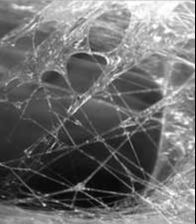|
What is fascia?
Fascia is a 3 dimensional tissue of the body ( the 'white stuff' that is over muscles and organs) - it literally 'holds us together'. It expands as we need to - such as reaching out, throwing or even running. Fascia is like the 'white stuff' seen in an orange or lemon - the fleshy bits are surrounded by it ). Fascia is found below the skin, but surrounds all organs and muscles, allows us to expand and contract, to move and yet come back to our original position. In the same way that an orange or lemon has 'flesh' which grows within the 'white stuff' - our muscles and tissues grow and expand within the fascia. 'So what? you might say .... The true role and components of fascia have only recently been discovered. New anatomical dissection methods, new ways of filming and exploring what happens 'under the skin' have introduced new ways of seeing how we really move. Whereas traditional teachings have focused on the role of 'muscles' - it is the fascia that controls how well those muscles work. It is the brain connections via the nerves that infiltrate this 'white stuff' that determine how much muscles and even which fibres might be activated when we want to move. It is NOT the muscles themselves therefore that have total control over how we move. If you look at a kangaroo hopping - it is the fascia that holds the elastic bounce and recoil capacity. Therefore ... This changes traditional ways of thinking and prescribing exercise. This means we need to look at the whole body and how it moves, to be able to effectively analyse what is happening when someone moves, or is trying to improve how they move. Fascia is formed by undulated collagen fibres and elastic fibres arranged in distinct layers, and within each layer the fibres are aligned in a different direction. Due to its undulated collagen fibres, fascia can be stretched and, because it has elastic fibres, it can also return to its original resting state. For more information about fascia & fitness, follow this link. Also feel free to follow our website over future weeks. |
|
Rather than acting individually, muscles are connected by fascia to enable us to perform movements.
e.g. the upper and lower limbs work together with the trunk when we want to run. No muscles work in isolation. The brain thinks in terms of 'movement' involving the whole body. |
Fascia - as seen under the skin.This is fascia as it exists under the skin. Like a 3 dimensional spider web, it allows movement in all directions. The blood and lymph vessels and nerves all pass through this fascia. It surrounds muscles and other organs, including in the abdomen and around the heart.
It is important therefore that the freedom and elasticity of the fascia is maintained - otherwise we risk losing mobility, flexibility and strength. |




